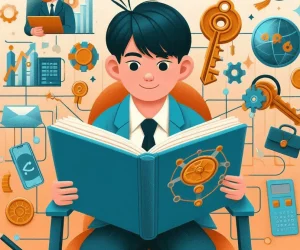Table of Contents
This story is part of Tech for a Better World, stories about the diverse teams creating products, apps and services to improve our lives and society.
Back in 2014, psychologists at the University of California, Berkeley, launched an online course with one goal: Teach students how to be happy in just eight weeks. No big deal, right?
The amazing thing: It seemed to work. Thousands of students took the Science of Happiness course (which is still free to audit on edX, a provider of open online courses) and learned about the science of connection, compassion, gratitude and mindfulness. Perhaps more importantly, they also completed a series of simple activities that research suggests increase happiness.
Those who fully participated saw their positive feelings increase each week. They reported feeling less sadness, stress, loneliness, anger and fear, while at the same time experiencing more amusement, enthusiasm and affection, as well as a greater sense of community. During the course, students’ happiness and life satisfaction increased by about 5%. And that boost remained even four months after the course ended (though it’s difficult to fully untangle that result; it could’ve been from doing the activities, the students’ new understanding of the psychology of happiness, or something totally different).

How does this work? Can you really change how happy you are that easily?
According to the research, yes. Even during challenging times, like the coronavirus pandemic.
The malleability of happiness
“There’s a misconception that happiness is built-in and that we can’t change it,” says Laurie Santos, a professor of psychology at Yale University who teaches a free Coursera class called The Science of Well-Being.
One popular theory that suggests we can affect our feelings is the happiness pie chart
, proposed in a 2005 paper (PDF) published in the Review of General Psychology. At the time, researchers suggested that while 50% of your happiness is determined by your genes and 10% by your life circumstances, 40% is determined by your daily activities. Though this breakdown has faced criticism (that it’s too simple, and doesn’t take into account how your genes and environment interact), it taps into an idea that’s fairly widely accepted: At least some of your happiness is within your control.
“The science shows that our circumstances — how rich we are, what job we have, what material possessions we own — these things matter less for happiness than we think,” Santos says. (Research does show that wealthier people are happier than poorer people
— but not by a ton.)
Another big misconception? That happiness is the same as a consistently positive emotional state, says Emiliana Simon-Thomas, who co-teaches Berkley’s The Science of Happiness course and is also the science director of Berkeley’s Greater Good Science Center. Being happy doesn’t mean you feel pure joy and cheerfulness every hour of every day. Humans aren’t designed that way (and think of how annoying you’d be if you were). You experience setbacks, problems, the loss of loved ones. And those negative feelings are an essential part of your emotional life, too.
Happiness, experts say, means accepting negative experiences, and having the skills to manage and cope with them, and to use them to make better decisions later.
“We think happiness is like a Facebook reel of vacations and achievements and checkboxes for life goals,” Simon-Thomas says. “But people who pursue happiness in that sort of belief system end up being less happy than people who define happiness in a more overarching, quality-of-life way.”

Nuttapong Charoenarparussamse/Getty Images
How to make yourself happier, according to science
The appealing thing about being able to control at least part of your own happiness is you can do it from home, or anywhere, for free. Here are five exercises that clinical studies have shown improve your feelings of happiness and well-being.
(An important caveat: For people with clinical anxiety, depression or other mental health issues, these exercises aren’t a replacement for therapy, medication or other professional interventions. However, some research suggests they can be beneficial as a supplement to those services.)
1. Enhance your social connections
Social connection is the biggest factor affecting happiness, multiple studies have found. One of the most convincing is the Harvard Study of Adult Development which, for more than 80 years has followed the lives of hundreds of participants and, now, their children.
Close relationships (with spouses, family, friends, community members) are the biggest factor keeping people happy throughout their lives, researchers discovered. People with strong relationships are happier, and physically and mentally healthier, than those who are less well-connected. (The researchers are still studying the connection between relationships and physical health — there’s evidence that good relationships result in lower levels of stress hormones, and less chronic inflammation.) Quality relationships (not quantity) are better predictors of a long and happy life than social class, IQ or genetics, according to the study.
Just how important relationships are came as a surprise, says Robert Waldinger, the current director of the study, whose 2015 TED Talk on the subject has been viewed more than 34 million times. “We figured that if you have good relationships, you’re likely to be happier, but we did not believe at first the data showing us that good relationships actually keep our bodies healthier and help us live longer. And then other studies began to find the same thing.”
These relationships require work, Waldinger says. You have to keep up with people, which means giving them your time and attention — especially during the pandemic. Call them, video chat with them, take a socially distanced walk if you can. Deliberately choose to spend time together.
Other ingredients for a long and happy life include not smoking or abusing alcohol, exercising regularly and finding work-life balance, the Harvard study found. “Rather than just being your grandmother’s good advice, there’s real science behind this,” Waldinger says. “You can quantify the number of years you’ll live longer, if you do these things.”
2. Engage in random acts of kindness

Sonja Lyubomirsky, a UC Riverside professor, found that purposefully engaging in random acts of kindness can make you feel happier.
Josh Blanchard
Find ways to perform small, random acts of kindness during your day. These acts can be incredibly simple, from complimenting a stranger at the grocery store on his or her shirt to making your spouse coffee before work to engaging a co-worker you don’t usually talk with in a friendly Zoom chat.
Deliberately performing random acts of kindness can make you feel happier and less depressed and anxious, according to a series of studies
(PDF) from Sonja Lyubomirsky at UC Riverside. Varying those acts you do for others has a longer-term effect on your own happiness.
This works because these acts tap into your natural prosocial behavior, or the basic human impulse to help others, Simon-Thomas says. When you invest your own resources in the welfare of others, it activates your brain’s reward system — you feel good that you made the other person feel good.
3. Express gratitude
Writing down three things you’re grateful for at the end of each day, and why they happened, leads to long-term increases in happiness and decreases in depressive symptoms, according to a 2005 study from Martin Seligman, director of the Positive Psychology Center at the University of Pennsylvania. It doesn’t matter how large or small each thing is — just write them down, in a notebook or your Notes app or wherever. For example, you might write down “Finished a paper, because I worked hard on it. Had a good talk with my friend because she called me. Went for a walk and saw some cute dogs, because it was a nice day.”

Getty/Natalie Board/EyeEm
The point is to train your mind to orient itself to the parts of your life that are good, instead of directing your attention to things that are stressful or irritating, Simon-Thomas says.
The pandemic might make it harder to feel grateful, but taking time to count your blessings even now is still a powerful way to improve well-being, Santos adds.
4. Practice mindfulness
You may have already tried all those mindfulness apps. But exercises like meditation that teach your brain to focus on the present instead of the past or future can increase feelings of self-acceptance
, according to a 2011 study from the International Journal of Wellbeing.
“The idea is to be present — don’t judge your emotions, but recognize them,” says Elizabeth Dunn, a psychology professor at the University of British Columbia. If you need a hand, Dunn helped launch a free set of wellness exercises called Peace, by the fintech company Happy Money. These exercises use research on positive psychology and cognitive behavioral therapy to increase happiness and reduce feelings of stress.
(Another caveat: If you have PTSD, proceed with caution or check with your doctor first, as mindfulness exercises may be triggering, experts say, because they can unearth trauma.)
5. Practice self-compassion
This might be the most challenging item on the list, Simon-Thomas says. Particularly in the West, people have adopted a propensity for self-criticism as a cultural value, and tend to self-punish when dealing with setbacks and failures, she says. But excessive self-criticism gets in the way of achieving your goals.
There are three parts to practicing self-compassion, and they draw on some of the other exercises on this list: Be present in the moment rather than dwelling on the past or looking anxiously to the future. Understand that setbacks are part of being human, and all people experience them. Cultivate a warm, supportive inner voice rather than a hostile, self-critical one.
You can work to hone your supportive inner voice by writing a letter to yourself, using the tone you’d use if you were writing to a relative or friend who’d asked for support, Simon-Thomas says. For example, if you lost your job, you might be beating yourself up over it. But if a friend lost his job, you’d be more likely to say: “Hey, this just wasn’t meant to be. You have so much to offer and will find the right opportunity.”
“It’s a way to tap into a different way of speaking to ourselves that’s important for being able to manage difficulties and setbacks, and grow from life’s challenges,” Simon-Thomas says.
One more big caveat: Race
Virtually every major study on happiness and well-being has one thing in common: The vast majority of researchers and participants are white. Lack of diversity is a big problem across most areas of psychological research: Of more than 26,000 empirical articles published between 1974 and 2018 in top-tier cognitive, developmental and social psychology journals, only 5% highlighted race, according to a study from Stanford University published in June. The majority of psychology journal editors and authors published were white, the study found.
“There’s a theoretical importance and social importance in just making sure that all humans are represented in our science,” says Steven O. Roberts, lead author of the study and an assistant professor of psychology at Stanford. “From a purely statistical point of view, you can’t take findings from a subset from middle class white Protestant US citizens and use that to make inferences about happiness, period. Because happiness extends obviously beyond that.”
Many of the basics of happiness research, and the efficacy of the exercises above, would likely hold true across racial groups, because underlying human biology is more powerful than the differences between groups, Waldinger says. This is especially true for social connections. However, the daily microaggressions and fears that people of color face could change the conditions of happiness for those groups, he adds.
One of the basic tenets of biological science is that race doesn’t play a role in how the brain responds to certain stimuli. However, researchers are also only beginning to learn more about epigenetics — an emerging field of science that studies how trauma may activate certain genes, and how people potentially pass those genes down to their children.
“The social experiences associated with racial identity can give rise to differences in our psychological experiences,” Roberts says. “Biologically, we’re all the same. There’s no biological basis to race. But there’s definitely a social basis to race.”
Diversifying research populations gives us a more accurate understanding of humanity as a whole, which could help us learn more about the foundations of happiness for everyone. After all, “people of color can be happy,” Roberts says. “Everyone can be happy.”





More Stories
Uvalde Border Patrol agent hailed as hero collects $17,000 in personal fundraiser
The Power Moves to Retain Teachers Amid the Pandemic
A Few of My Favorite Healthy Meals and Where to Buy Them